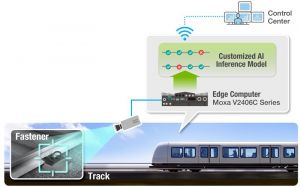
How AIoT Keeps Mass Transit Systems on Track
The advent of the Industrial Internet of Things (IIoT) has allowed a wide range of businesses to collect massive amounts of data from previously untapped sources and explore new avenues for improving productivity. By obtaining performance and environmental data from field equipment and machinery, organisations now have even more information at their disposal to make informed business decisions. Unfortunately, there is far too much IIoT data for humans to process alone. Consequently, most of this information goes unanalysed and unused. It is no wonder that businesses and industry experts are turning to artificial intelligence (AI) and machine learning (ML) solutions for IIoT applications to gain a holistic view and make smarter decisions more quickly.
Keeping trains on track is easier said than done
All trains—whether in an inter-city railway line or municipal mass transit system—run on metal tracks that need to remain upright and properly spaced according to a standard gauge at all times. If the tracks become uneven, trains could derail. That’s why you always see some sort of support, known as railroad ties or ballasts, laid perpendicularly beneath the tracks. To ensure a smooth ride, railroad tracks need to be securely fastened to the ties by spikes, screws, or bolts. Due to constant friction and vibration between fast-moving train wheels and the tracks, as well as damage from the natural environment, track fasteners degrade and break over time. Consequently, timely detection and repair of track fasteners is crucial to ensuring the safety of any railway line.
A large metropolitan railway in East Asia needed a more efficient way to inspect the vast number of fasteners used to stabilise thousands of miles of tracks throughout its entire mass transit system. Located in the Ring of Fire where many earthquakes occur, the transit system cannot take any chances on the safety of its infrastructure since constant tremors compound the regular wear and tear from rolling stock and high passenger traffic. Usually, after the train service ends on one of the lines, the railway operator dispatches human maintenance engineers to perform manual visual inspection of the tracks and check for loose fasteners. If a loose or damaged track fastener is detected, it will be repaired before train services recommence on the line.
Putting AIoT to work for faster and accurate fault detection
Since visual inspection of railway tracks during non-operating hours is time-consuming and human fatigue may lead to data omission, the transit system decided to deploy an AI edge computing solution that could accelerate track fastener inspection with computer vision. More specifically, the transit operator wanted a customised AI inference model with object recognition for track fastening systems that could detect track fastener defects while the trains are moving and perform maintenance between journeys. AI inferencing for track fastener inspection also requires the edge computer to have powerful computing performance and storage expansion for video data, compact size and fanless design for installation in small cabinets, wide operating temperature range, and EN 50155 compliance for use on rolling stock.

The solution
The first step was to install high-resolution cameras underneath the train carriages, which enabled the system operator to capture real-time video of track fasteners as trains run on the tracks during service hours. Video data is then transmitted to an onboard edge computer for image processing and object recognition of track fastener defects. The train operator selected Moxa V2406C Series rail computer for its compact-size with an Intel® Core™ i7 processor that provides ample computing power for running the trained AI inferencing model. The V2406C also runs on low power consumption and has a wide operating temperature range of -40 to 70°C. Last but not least, the V2406C supports the Intel® OpenVINO™ toolkit and features two mPCIe slots for Intel® Movidius™ VPU modules to accelerate image recognition computations and edge AI inferencing. By replacing manual visual inspection with real-time AI visual inspection during operating hours, the transit system was able to improve efficiency and reduce maintenance expenses.
To learn more about deploying edge-computing platforms for AIoT in real-world industrial applications and for more example use cases, download Moxa’s Industrial AIoT white paper.
